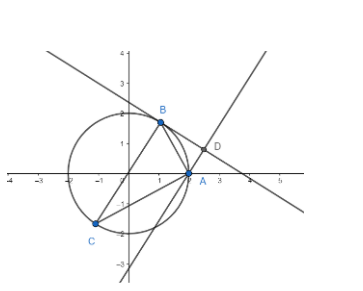
The pedal equation of the circle ${{x}^{2}}+{{y}^{2}}=4$ with regard to the point (2,0) is
[a] ${{r}^{2}}=4$
[b] $4p={{r}^{2}}$
[c] ${{p}^{2}}=4r$
[d] $p=4{{r}^{2}}$
Answer
584.4k+ views
Hint: Use the property that the tangent of a circle and the radius are perpendicular to each other at the point of contact. Use the property that angle in a semicircle is a right angle. Hence prove that the angles $\angle \text{ABD}$ and $\angle \text{BCA}$ are equal. Use trigonometry to get a relation between AB, AD and BC. Substitute AD = p, AB = r and BC = 4 to get the required pedal equation.
Complete step-by-step answer:

Pedal equation: Definition: Pedal equation of a curve C and given fixed point O is the relation between r and p, where r is the distance if point O to a point on the curve C and p is the perpendicular distance of O from the tangent line drawn at that point. The point O is called the pedal point and the values r and p are known as the pedal coordinates of the curve C w.r.t the pedal point.
Here we have, the pedal point is A (2,0), and B is any point on the locus. BD is the tangent at point B, and AD is the perpendicular from A on BD. C is the diametrically opposite point of B.
Hence, we have AD = p and AB = r.
Since BC is a diameter, we have $\angle \text{BAC=90}{}^\circ $
Let $\angle \text{BCA=}\theta $.
Hence we have
$\angle \text{CBA=90}{}^\circ \text{-}\theta $
Since BD is a tangent and BC is a diameter, we have $\angle \text{CBD=90}{}^\circ $
Hence, we have $\angle \text{ABD=}\theta $
In triangle ABD, we have $\sin \theta =\dfrac{\text{AD}}{\text{AB}}\text{ (i)}$
In triangle ABC, we have $\sin \theta =\dfrac{\text{AB}}{\text{BC}}\text{ (ii)}$
From (i) and (ii), we get
$\dfrac{\text{AD}}{\text{AB}}=\dfrac{\text{AB}}{\text{BC}}$
Since for circle with equation ${{x}^{2}}+{{y}^{2}}={{a}^{2}}$ radius = a, we have BC = 4.
Put AD = p, AB = r and BC = 4, we get
$\begin{align}
& \dfrac{p}{r}=\dfrac{r}{4} \\
& \Rightarrow 4p={{r}^{2}} \\
\end{align}$
which is the required pedal equation of the circle.
Hence option [b] is correct.
Note: In the pedal equation, we denote distance of any point on the locus from the pedal point by r and the distance of the pedal point from the tangent at the point on the locus by p. We then find the relation between p and r. This relation is called the pedal equation of the curve.
Alternative Solution:
Pedal equation of a circle with respect to any point on the circumference of the circle is given by $pd={{r}^{2}}$, where d is the diameter of the circle.
Here d = 4.
Hence the pedal equation is $4p={{r}^{2}}$ .
Complete step-by-step answer:

Pedal equation: Definition: Pedal equation of a curve C and given fixed point O is the relation between r and p, where r is the distance if point O to a point on the curve C and p is the perpendicular distance of O from the tangent line drawn at that point. The point O is called the pedal point and the values r and p are known as the pedal coordinates of the curve C w.r.t the pedal point.
Here we have, the pedal point is A (2,0), and B is any point on the locus. BD is the tangent at point B, and AD is the perpendicular from A on BD. C is the diametrically opposite point of B.
Hence, we have AD = p and AB = r.
Since BC is a diameter, we have $\angle \text{BAC=90}{}^\circ $
Let $\angle \text{BCA=}\theta $.
Hence we have
$\angle \text{CBA=90}{}^\circ \text{-}\theta $
Since BD is a tangent and BC is a diameter, we have $\angle \text{CBD=90}{}^\circ $
Hence, we have $\angle \text{ABD=}\theta $
In triangle ABD, we have $\sin \theta =\dfrac{\text{AD}}{\text{AB}}\text{ (i)}$
In triangle ABC, we have $\sin \theta =\dfrac{\text{AB}}{\text{BC}}\text{ (ii)}$
From (i) and (ii), we get
$\dfrac{\text{AD}}{\text{AB}}=\dfrac{\text{AB}}{\text{BC}}$
Since for circle with equation ${{x}^{2}}+{{y}^{2}}={{a}^{2}}$ radius = a, we have BC = 4.
Put AD = p, AB = r and BC = 4, we get
$\begin{align}
& \dfrac{p}{r}=\dfrac{r}{4} \\
& \Rightarrow 4p={{r}^{2}} \\
\end{align}$
which is the required pedal equation of the circle.
Hence option [b] is correct.
Note: In the pedal equation, we denote distance of any point on the locus from the pedal point by r and the distance of the pedal point from the tangent at the point on the locus by p. We then find the relation between p and r. This relation is called the pedal equation of the curve.
Alternative Solution:
Pedal equation of a circle with respect to any point on the circumference of the circle is given by $pd={{r}^{2}}$, where d is the diameter of the circle.
Here d = 4.
Hence the pedal equation is $4p={{r}^{2}}$ .
Recently Updated Pages
A man running at a speed 5 ms is viewed in the side class 12 physics CBSE

State and explain Hardy Weinbergs Principle class 12 biology CBSE

Which of the following statements is wrong a Amnion class 12 biology CBSE

Two Planoconcave lenses 1 and 2 of glass of refractive class 12 physics CBSE

The compound 2 methyl 2 butene on reaction with NaIO4 class 12 chemistry CBSE

Bacterial cell wall is made up of A Cellulose B Hemicellulose class 12 biology CBSE

Trending doubts
What are the major means of transport Explain each class 12 social science CBSE

Which are the Top 10 Largest Countries of the World?

Draw a labelled sketch of the human eye class 12 physics CBSE

Explain sex determination in humans with line diag class 12 biology CBSE

Give 10 examples of unisexual and bisexual flowers

State the principle of an ac generator and explain class 12 physics CBSE




